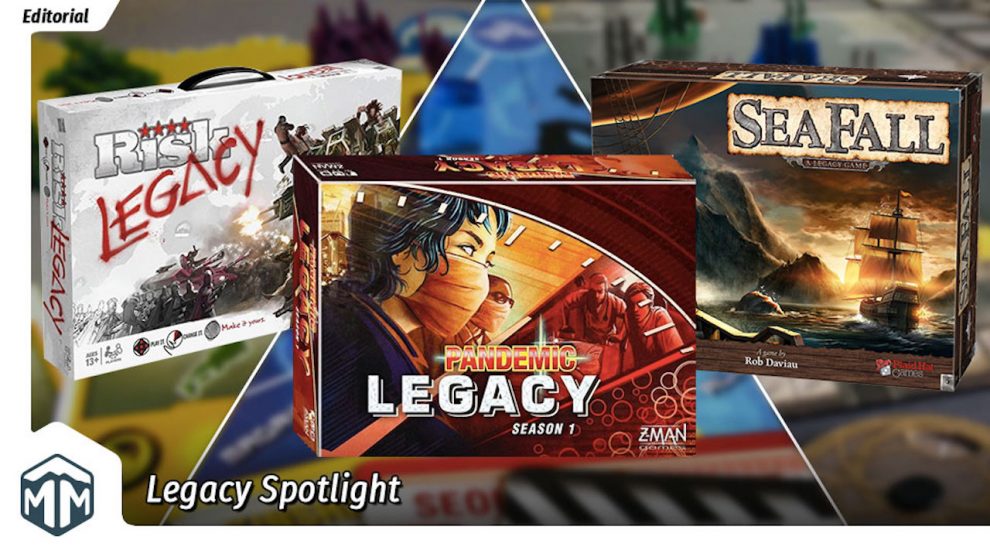What is a legacy game?
A “legacy game” is a special type of game that requires multiple game plays, wherein the game state changes as the game progresses. It is different from simply a game with a built-in campaign, such as Descent, Imperial Assault, or Mechs v. Minions. In legacy games, the board and game components themselves actually become permanently altered. This may entail writing on the board, putting stickers on character sheets, or even tearing up cards, permanently destroying game components.
Needless to say, the first time I played a legacy game, the idea of altering or destroying parts of a game was downright insane. I quickly got over my reservations, and began looking forward to the next time I could enthusiastically rip a card in half, mark up the board with permanent ink, or attach new stickers. Some of the people in my current playgroup are still apprehensive about effectively destroying parts of the game, but most people that I’ve played with usually catch on quickly and become just as excited as I am to permanently change the game.
Presently, there are three legacy games on the market:
- Risk: Legacy
- Pandemic: Legacy
- Seafall
Risk: Legacy
Risk: Legacy was the first legacy game created by Rob Daviau, published by Hasbro. Risk: Legacy takes the familiar classic game of Risk and turns it upside down. It fixes some of the inherent problems with the original game, in addition to adding the legacy aspects of the game. One problem that original Risk suffers from is the concept of “turtling.” Turtling is when a player just sits and lets troops accumulate without actually engaging in the rest of the game. Growing up playing Risk, this would usually be the first person to take Australia. This would usually lead to massive 50+ armies endlessly rolling dice until the attacker decided to stop. More often than not, we’d either surrender or agree to a stalemate rather than sit through round after round of monotonous dice-rolling.
Risk: Legacy fixes this by setting a different victory condition. At the start of the game, each player has chooses one city to be their headquarters. (HQ) The winner is the first to accumulate four Red Stars, obtained by either capturing enemy HQ’s or trading in four resource cards. Resource cards are obtained by conquering at least one territory on your turn.

Since the Red Stars are only obtained through capture and conquest, players cannot win by just sitting back and turtling. This also leads to a shorter play time, as the game no longer requires one player to destroy all the others in order to win.
The game also changes up the experience by having variable player powers. As opposed to simply playing the “red” or “green” army, you have a specific and distinct faction with its own special abilities.
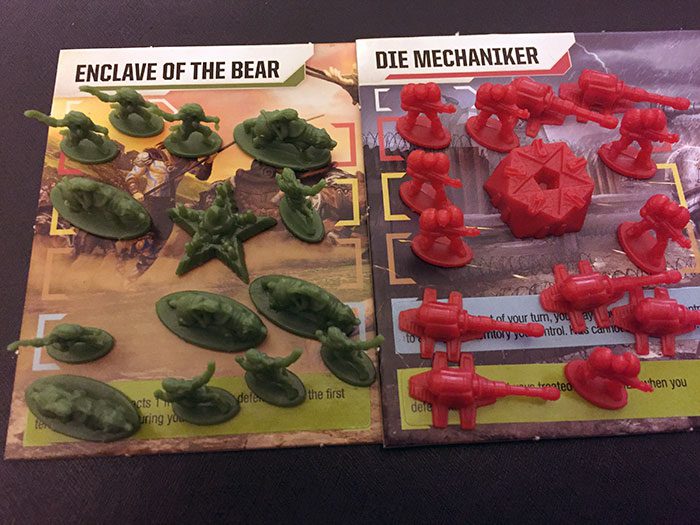
While these rule changes alone make the game of Risk more enjoyable, what makes the game shine is the legacy aspect. Included in the box are sealed compartments, not to be opened until a specified condition has been met.
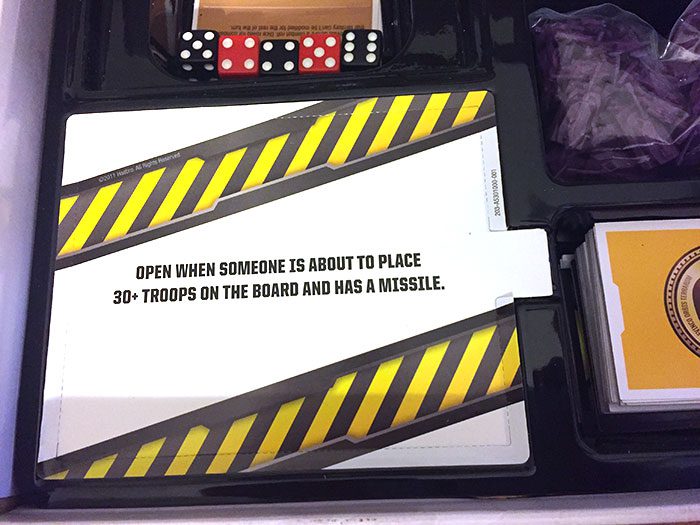
Additionally, at the end of each game, the winner of the game gets an additional bonus, usually the opportunity to add something to the board or the cards that will benefit them in future games. This may involve creating and naming a city on the board, upgrading their faction, etc. The other players will also be able to upgrade, but to a lesser degree.
Full disclosure: I have not yet completed Risk: Legacy. Through some combination of loss of interest, changing schedules, and life events, our playgroup of the maximum five players only got through 6 games, then fell apart.
While Risk: Legacy was an innovative and unique experience, at its core it is still just Risk. It was hard to get excited about playing it once we had unlocked nearly all of the special compartments. In this age of modern board gaming, the basic mechanics of Risk, even with the added flair, still felt dated. Risk: Legacy, while initially exciting, eventually just fizzled out for me.
Pandemic Legacy
Similar to Risk: Legacy, Pandemic Legacy took an existing game and built upon it. Pandemic is a cooperative game by Matt Leacock about fighting multiple diseases across the world and preventing global collapse. It’s been an undeniable hit, with multiple expansions and spin-offs. It has an engaging theme, as well as relatively simple gameplay despite its overall difficulty. Like many cooperative games, there are many ways to lose but only one way to win. Each player takes on a different role, each with a different special ability. The roles are incredibly thematic. The medic, for example, is better at treating disease while the scientist can discover a cure more easily.
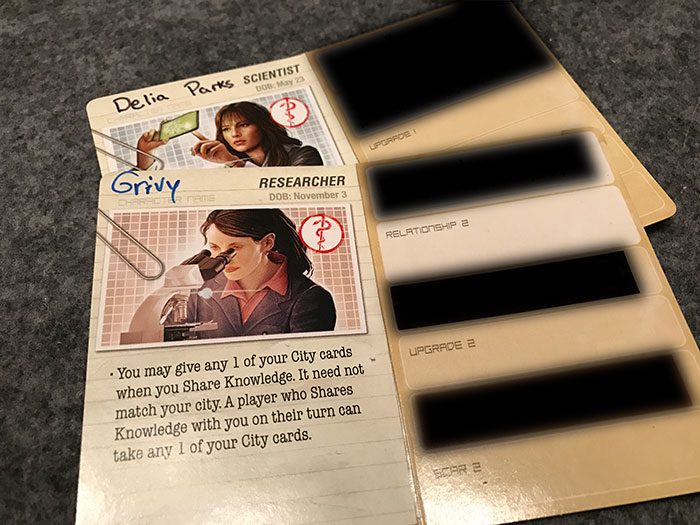
Pandemic is by its own right a fantastic game, but the built-in narrative of the game–specialists racing to save the world from falling to devastating diseases–was ripe for a legacy game. Matt Leacock and Rob Daviau apparently felt the same. In October of 2015, Pandemic: Legacy arrived on the scene with a bang. It quickly shot up the BoardGameGeek.com ratings, and reached #1 overall, where it still stands.
Pandemic: Legacy takes the world of Pandemic and creates a narrative story arc, from beginning to end. I won’t spoil anything here, but suffice to say that the story surprised me at several turns. The game is played out over the course of one game year divided into 12 months. Each month has a set of objectives that must be completed in order to win that particular game. Players are given two chances to beat each month, before the game moves on to the next month. The game progression is handled masterfully by the use of the legacy deck.

The legacy deck guides the players, instructing them when to proceed. The game also comes with loads of stickers that will inevitably be put on the game board, characters, and even the rule book. It was a wonderful surprise when I first looked at the rule book, and entire pages were blank, waiting for new rules to be introduced and added to the game.
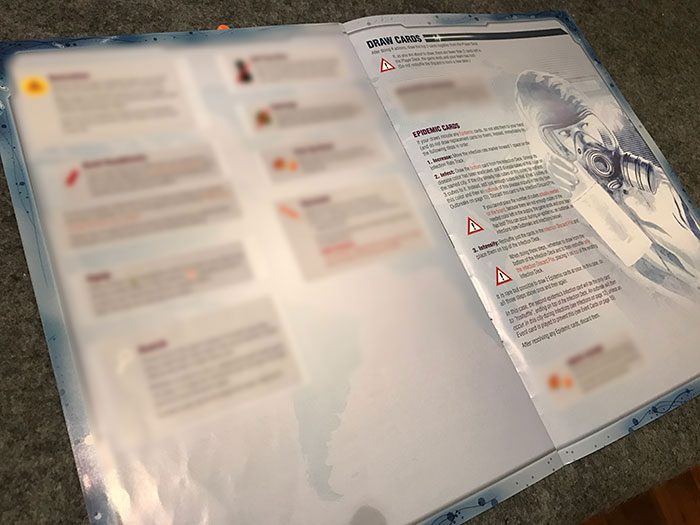
Throughout the course of the game, you’ll be naming your characters, giving them relationships, upgrading their powers, and potentially scarring them with negative penalties. Additionally, whenever a city outbreaks–accumulates more than three of the same color disease– the city is permanently affected.

Because of these ongoing effects, and the cooperative nature of the game, Pandemic: Legacy creates a sense of urgency and high stakes. You know that the choices you make in January, game 1, will affect you throughout the rest of the game. If you let Tokyo fall in one game, it will stay fallen.
My feelings about this game are no mystery. In a previous article I suggested that Pandemic Legacy might be ‘The future of board gaming’. I’ve played through the game three times with three different playgroups. While the story, driven by the legacy deck, was the same, each game turned out differently based on our choices and how the game played out. Each respective world ended up looking differently.
Pandemic Legacy is responsible for some of my most memorable game experiences that will forever be etched in my memory. Like a modern television series a la Breaking Bad or The Walking Dead, Pandemic Legacy weaves a story through multiple episodes that is extremely captivating and equally satisfying. Quite simply, Pandemic Legacy defied my expectations of what a board game could be.
Seafall
Given the overwhelming success of Risk: Legacy and Pandemic: Legacy, when I found out that Rob Daviau had another legacy game in the works, I was incredibly excited. What’s more, this game, rather than building off an existing property, would be a brand new game of its own. I wasn’t the only one with lofty expectations for what this could be. News came out that it was a game about building a seafaring empire in the age of colonization. The hype for Seafall kept growing, both within myself and in the general gaming community. When game publisher Plaid Hat Games finally released a limited number of copies at GenCon, they sold out instantly. I finally got my copy of Seafall in October 2016 and immediately got together four other people to go through the campaign. To date, we have played 5-6 games of a potential 10-15.
Seafall is a sprawling empire-building game with a heavy focus on exploration and economics. While exploration and elements of combat are dice-driven, at its heart Seafall is a euro-style game that is as much about building an efficient victory point engine as it is anything else. Players get “glory” from successful explorations and raids, as well as simply purchasing upgrades, buildings, and treasures. All of these options will require you to build up the resources necessary to perform them, generally through buying and selling goods.

Each turn, a player can hire an advisor that adds a particular bonus to selling, exploring, etc, then take two actions related to a particular guild. The merchant guild allows you to buy and sell goods. The soldiers guild lets you collect taxes and perform raids. The explorer’s guild allows you to explore available undiscovered locations on the board or take a research card, a one-time use special ability that can be kept from game to game. Additionally, each guild allows you to sail. Since you are only able to do two of these actions per turn, the game requires you to plan out your turns efficiently and effectively.
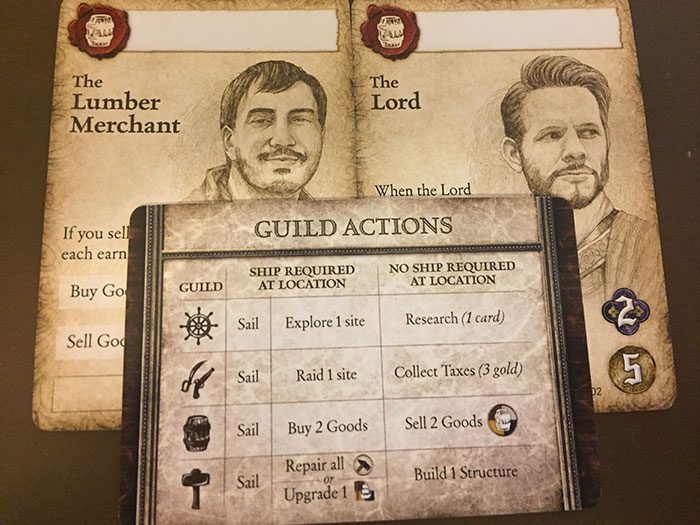
The game does come with a number of unlockable boxes with unknown components, and getting to open those by accomplishing certain milestones throughout the game has been an enjoyable part of the game.

While this game doesn’t have quite the directed narrative element that Pandemic Legacy has, it does have some story to it in the form of a Captain’s Book. Upon completion a successful exploration of an unknown site, a player selects a passage from the Captain’s Book and reads it aloud.
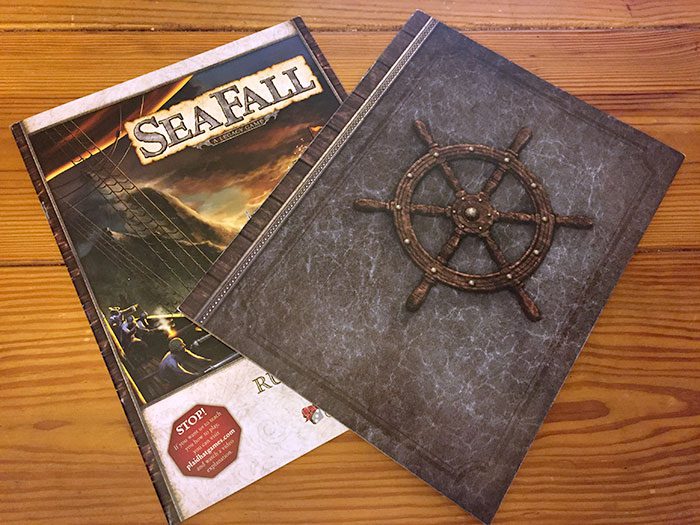
These generally present the player with a scenario that requires them to choose between a few different options. Then similarly to a choose-your-own-adventure book, the player turns to a different passage to find out the result of their choice, which will usually mean obtaining some type of resource or some amount of gold. Since the order that passages are read are somewhat random, it’s less of an overarching story and more of a general plot setting with bite-size morsels of story that hint at something grander. So far in my campaign, this has yet to deliver the kind of narrative experience that I enjoyed so much in Pandemic Legacy.
Despite that fact that Seafall is nothing like what I expected given my experiences with the previous two legacy games, nonetheless I’m still enjoying the campaign. The game is more cerebral than visceral, more thinky than dramatic, more efficient engine-building than edge-of-your-seat excitement. I fear however that it may suffer the same fate as Risk: Legacy, in that once we have opened enough of the secret boxes, we may lose interest in actually completing the campaign.
From what I can tell from others who are playing or have played the game, the overall reception has been fairly lukewarm. I think that some of the lukewarm reception to Seafall is a matter of the experience not meeting expectations. That’s not necessarily a fault of the game, but given how much hype there was for the game, the game was destined to disappoint. Fairly or not, it looks as though the game could never live up to the hype. Overall, Seafall is a pretty solid Euro game with some built-in storytelling and legacy elements.
Why Legacy?
One major criticism with legacy games in general is their lack of replayability. Once the campaign is over, you’re pretty much done with it, at least for the current generation of legacy games. For some gamers, this is an unforgivable sin, and I get that. However, I like to think of it from a different context.
Legacy games are less about the game itself as they are the overall experience. Pandemic Legacy provided me with the greatest experiences that I have ever had playing games. LIke a movie with a twist ending, after you’ve experienced it once you won’t necessarily ever be able to enjoy it the same way again. It doesn’t mean the movie wasn’t incredible; it’s just an experience that won’t be replicated.
I can understand If the fact that a game is ultimately consumable is a deal-breaker. However, I would encourage everyone to give legacy games a chance. I don’t want anyone to miss out on what could be an unforgettable and incredibly fun game experience. If these particular games don’t suit your fancy, there are more legacy games on the near horizon.
- Ultimate Werewolf Legacy, from designers Ted Alspach and Rob Daviau, is based on the hit social deduction party game Ultimate Werewolf. Players take on secret roles, and will gain attributes and special abilities that will carry over from game to game.
- Chronicles 1: Origins, from designers Dirk Knemeyer and Rob Daviau, is a unique 4x civilization game that will have players take a tribe from the Stone Age into the Bronze Age. Chronicles 1: Origins will have legacy elements within the game but will also introduce the “echo system.” Using the echo system the civilization you create in Chronicles 1: Origins will carry over into future Chronicles games, allowing you to take the civilization you created in Origins and advance it further into history.
- Gloomhaven, from designer Isaac Childres, is a cooperative legacy game with card-driven tactical combat set in a fantasy realm that has your adventurers clearing out dungeons, fighting monsters, and creating a unique story through a series of “Choose Your Own Adventure” style scenarios.
- Charterstone, from designer Jamey Stegmaier, is a competitive city-building game that will feature Euro-style mechanics like worker placement, engine-building, resource management, and action selection. As players’ cities grow, they will be increasing and upgrading the available action spaces. Once the legacy game is completed, it will be a replayable as a worker-placement game, completely unique to each playgroup depending on their choices throughout the campaign.
What do you think about legacy games? Which legacy games have you played or are interested in playing? Let us know in the comments below.


